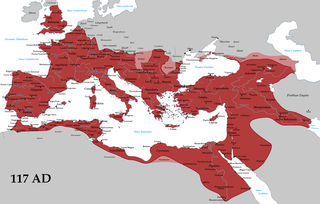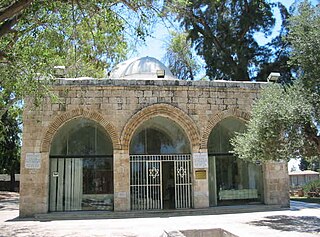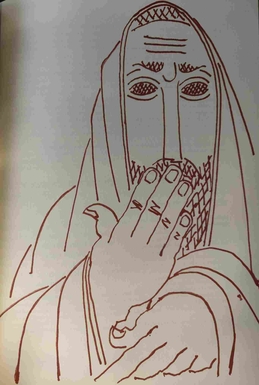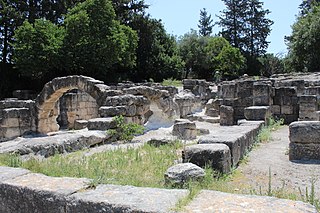Life

The Talmud reports that, in the mid-first century, he was particularly active in opposing the interpretations of Jewish law (Halakha) by the Sadducees [2] [3] and produced counter-arguments to their objections to the interpretations of the Pharisees. [4] So dedicated was he to opposing the Sadducean view of Jewish law that he prevented the Jewish high priest of his time, a Sadducee, from following the Sadducaic interpretation of the Red Heifer ritual. [5]
His home at this time was in Arraba, a village in the Galilee, where he spent eighteen years. [6] [7] Although living among them, he found the attitude of Galileans to be objectionable, allegedly exclaiming that they hated the Torah and would therefore "fall into the hands of robbers." [6] During the outbreak of hostilities, he settled in Jerusalem.
Escape from Jerusalem (Gittin 56a)
During the siege of Jerusalem in 70 CE in the First Jewish–Roman War, he argued in favour of peace: according to the Talmud ( Gittin 56a), when he found the anger of the besieged populace to be intolerable, he arranged a secret escape from the city inside a coffin, helped by his nephew and Zealot leader Ben Batiach, so that he could negotiate with Vespasian (who, at this time, was still just a military commander). [6] [8] Ben Zakkai correctly predicted that Vespasian would become Emperor and that the Temple would soon be destroyed. In return, Vespasian granted Yochanan three wishes: the salvation of Yavne and its sages and the descendants of Rabban Gamliel, who was of the Davidic line, and a physician to treat Rabbi Zadok, who had fasted for 40 years to stave off the destruction of Jerusalem. [9]
Yavne and afterwards
Upon the destruction of Jerusalem, Yochanan converted his school at Yavne into the Jewish religious centre, insisting that certain privileges given by Jewish law uniquely to Jerusalem should be transferred to Yavne. [10] His school functioned as a re-establishment of the Sanhedrin so that Judaism could decide how to deal with the loss of the sacrificial altars of the temple in Jerusalem and other pertinent questions. Referring to a passage in the Book of Hosea ("I desired mercy, and not sacrifice"), [11] he helped persuade the Sanhedrin to—as the temple had been destroyed—replace animal sacrifice with prayer, [12] a practice that remains the basis of Jewish worship. Eventually, Rabbinic Judaism emerged from the council's conclusions.
In his last years, he taught at Bror Hayil, near Yavne. [13] His habit was to wear his Tefillin (phylacteries) all day, both in summer and winter. [14] However, during the hot summer months, he only wore his arm phylactery (shel yad). [14] His students were present at his deathbed and were requested by him, in his penultimate words according to the Talmudic record, to reduce their risk of ritual contamination conveyed by a corpse:
Put the vessels out of the house, that they may not become unclean... [15]
More enigmatic were the Talmud's record of his last words, which seem to relate to Jewish messianism: [6]
...prepare a throne for Hezekiah, the King of Judah, who is coming [15]
According to the Talmud, Yochanan ben Zakkai lived 120 years. [16] Upon his death, his students returned to Yavneh, and he was buried in the city of Tiberias; eleven centuries later, Maimonides was buried nearby. As leader of the Sanhedrin, he was succeeded by Gamliel II.
Yochanan's encounter with Vespasian
This section contains too many or overly lengthy quotations .(May 2021) |
The following story is told in the Jewish classic, Avoth deRabbi Nathan, version B, chapter 4:5, about the war with Rome.
When Vespasian came to destroy Jerusalem, he said to them: 'You fools! Why do you seek to burn down the holy house? After all, what am I asking of you? I merely ask that you relinquish unto me each man his bow and arrow, and I will depart from you.' They answered him in return: 'Just as we went out against two [Roman armies] that came before you and killed them, so, too, will we go out against you and kill you!' (i.e., the reference is to the Roman general Cestius who was defeated by the Judeans in 66 CE, marking the beginning of the war with Rome).
When our Master, Yochanan ben Zakkai, heard these words, he called out to the men of Jerusalem and said to them: 'My sons, why would you destroy this city, or seek to burn down the holy house!? After all, what is he (i.e., Vespasian) asking of you? Look, he's not asking from you anything except that you relinquish your bows and arrows, and he'll depart from you.' They replied to him: 'Just as we went out against two [Roman armies] before him and killed them, so, too, we will go out against him and kill him.'
Vespasian had armored men positioned along the walls of Jerusalem, and informants within the city. Everything that they'd hear, they'd write it down upon arrows and shoot the arrows outside the wall, one of which said that Rabban Yochanan ben Zakkai was among those that admired the Caesar, and that he'd make mention of this fact to the people of Jerusalem.
When Rabbi Yochanan b. Zakkai's repeated warnings went unheeded, he sent and called for his disciples, Rabbi Eliezer [ben Hyrcanus] and Rabbi Yehoshua [ben Hananiah]. He said to them: 'My sons, stand up and take me out of this place! Make me a coffin and I'll sleep in it.' Rabbi Eliezer held on to the front end of the coffin, and Rabbi Yehoshua held on to the back end. They carried the coffin as he laid in it until sunset, until they stopped at the gates of Jerusalem's walls. The porters at the gates enquired who it was that had died. They answered them: 'It's a dead man, as if you did not know that we're not permitted to let a corpse remain within Jerusalem overnight!' The porters replied: 'If it's a dead man, remove him.' They then removed him, and remained with him until the sun had set, which, by that time, they had reached Vespasian. They opened up the coffin and he stood up before him. He (i.e. Vespasian) enquired of him: 'Are you Rabban Yochanan ben Zakkai? Ask what I shall give you.' He said to him: 'I ask for nothing, except Yavneh (Jamnia). I will go and teach therein my disciples, and I'll establish therein prayer, and I'll perform therein all of the duties prescribed in the divine Law.' He answered him: 'Go, and do all that you want to do.' Rabbi Yochanan ben Zakkai then said to him: 'Would you like me to tell you something?' Vespasian answered him: 'Say it.' He said to him: 'You are destined to rule over the Roman Empire!' He asked him: 'How do you know that?' He replied: 'Thus has it been passed down unto us, that the holy house will not be given into the hands of a mere commoner, but rather into the hands of a king, as it says (Isaiah 10:34): He shall cut down the forest thickets with an iron [instrument], and Lebanon shall fall by a mighty one.'
They said that no more than two or three days had passed when a certain messenger came from his city, informing him that Caesar had just died, and that they have nominated him to head the Roman Empire. They brought unto him a catapult made of hardened cedar wood, and turned it toward the wall of Jerusalem. They brought unto him planks of cedar wood and put them into the catapult made of hardened cedar wood, and he would hit the wall with them until he made a breach in the wall...
When Rabban Yochanan ben Zakkai heard that he (i.e., Caesar's son, Titus, who was left to govern the Roman army) destroyed Jerusalem and burnt down the holy house with fire, he rent his clothes, and his disciples rent their clothes, and they were crying and shouting and pounding their chests as mourners, etc.









